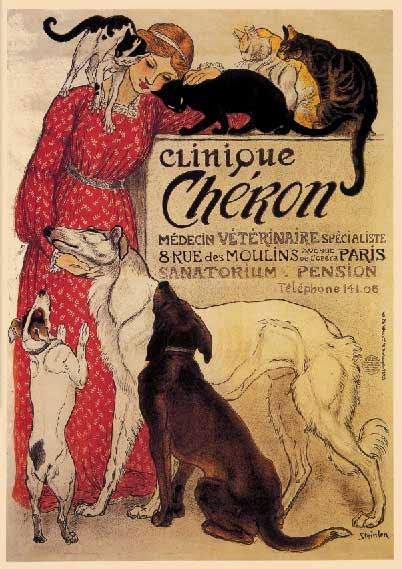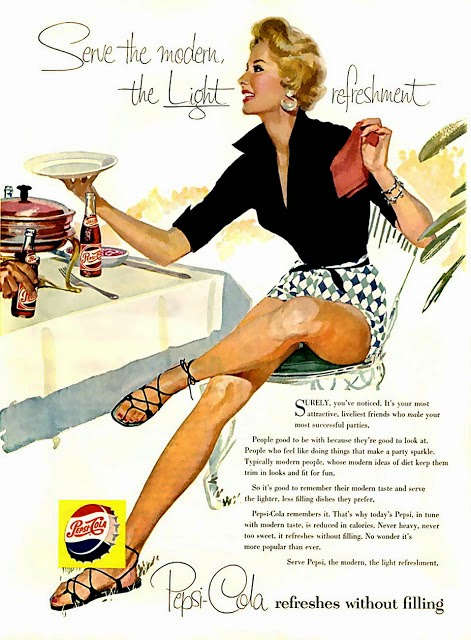Jules Cheret has been hailed as both the "father of the modern poster" and the "father of women's liberation" (Meggs, 2006, p 201-202). He was prolific in his creation of posters and advertisements, having created over a thousand posters, and his work led to his induction into the French government's Legion of Honor. But it was the subjects of his work as much as the quality that created his popularity. Cheret once said that an advertisement "need not show its product, as long as it evoked a feeling that conveyed amusement, enchantment, or enticement toward the product" (Edwards), and he accomplished this through heavy use of beautiful women as the central focus. The women of his work were dubbed "Cherettes" and were wildly popular. But some consider the Cherettes as "an unhealthy first step towards media promoting impossible body types for women" (Stock-Allen, 2011). Cherettes were heavily idealized - women who flouted the accepted norms and wore revealing clothing and indulged in risque behaviors for women of the time. This drove their popularity amongst both men and women and spurred the use of the figures in advertisements for many items, including "beverages and alcohol, perfumes, soaps, cosmetics and pharmaceutical products. Eventually he was promoting railway companies as well as a series of manufacturing businesses" (Collins, 2008).
 |
| Cheret poster. Source: InternationalPoster.com |
Another major figure in the art nouveau movement was Czech artist Alphonse Mucha, who was also known for his use of the female figure. Mucha exploded on the art scene after taking on a commission to design a poster for actress Sarah Bernhardt's new play, Gismonda. Meggs describes Mucha's figures as "project[ing] an archetypical sense of unreality. Exotic and sensuous while retaining an aura of innocence, they express no specific age, nationality, or historic period" (2006). Also like Cheret, Mucha was very prolific in the world of advertising. He frequently designed posters for the theatre, as well as "a whole host of consumable products that remain some of his most recognizable work" (Walsh, 2014).
Cheret and Mucha were not the only artists of the movement to focus on female form. Most of the artists of the era incorporated it into their works either extensively or occasionally in their advertising work. The work ranged from innocent to somewhat erotic. Henri de Toulouse-Lautrec had a much smaller body of work, producing only 31 posters, but his work depicting the Moulin Rouge and cabarets of the time are iconic. Belgian designer Privat-Livemont is cited as "an excellent example of female sensuality used in the service of commerce" (Stock-Allen, 2011). Theophile-Alexandre Steinlein heavily depicted felines in his works, but did occasionally utilize women as figures, often in a less erotic, though still romantic way.
 |
| Toulouse-Lautrec. Source: hoocher.com |
 |
| Privat-Livemont. Source: Wikimedia Commons |
 |
| Steinlein. Source: GreatVintageGraphics.com |
Fast forward to the pin up art popular in the 1940s and 50s and it is easy to see the source of inspiration. Artists like Gil Elvgren, Bill Randall, and Alberto Vargas drew women who show the same idealized beauty and attractive energy as their predecessors. The Cherettes were supplanted by the Gibson girls, and while advertisements changed somewhat in artistic style, they are just a variation on a theme. Beautiful women in striking poses with elegant hair and risque clothing still dominate as the central selling figure. The figure in the Pepsi ad recalls Cheret's art seen earlier, while the woman in the Claussner Hosiery ad is drawn with much of same curvilinear organic lines seen in many art nouveau works, and the Kool cigarettes woman is just a modern Job cigarettes woman.
 |
| Source: PinUpCartoonGirls.com |
 |
| Source: PinUpCartoonGirls.com |
 |
| Source: PinUpCartoonGirls.com |
In the present, women are still a central figure in advertising, although the advertisements often verge away from the elegant artistry of earlier works into a more aggressive sexuality and in the depiction of women. Still, some of those influences remain. It is easy to see how these works owe an allegiance to the advertisements created in the art nouveau period, and merely impress new styles and accepted cultural norms onto a framework created by the likes of Cheret and Mucha.
 |
| Source: Brewbarn.Ecrater.com |
 |
| Source: research-methodology.net |
 |
| Source: PETA |
Sources:
Collins, N. (2008). Jules Charet (1836-1932). Retrieved from http://www.visual-arts-cork.com/famous-artists/jules-cheret.htm
Edwards, E. (2008). The development of posters. Retrieved from
http://www.erinedwardsdesigns.com/dev_post/f1_d1.html
Meggs, P.B., Purvis, A.W. (2006). Meggs' history of graphic design. Hoboken, N.J.: J. Wiley & Sons.
Stock-Allen, N. (2011). Paris & the belle epoque poster craze. Retrieved from http://www.designhistory.org/Poster_pages/LaBelleEpoque.html
Walsh, G. (2014). Masters of the poster: Cheret, Mucha, and the new art of advertising. Retrieved from http://mirappraisal.com/masters-of-the-poster-cheret-mucha-and-the-new-art-of-advertising/





